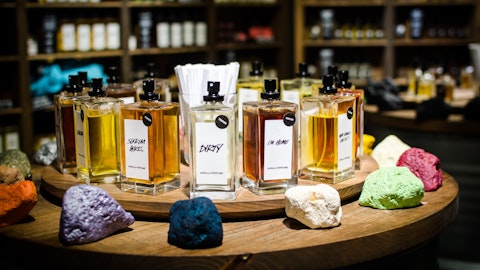But I would tell you that the wins that we’re seeing are pretty broad-based and a lot of the difference is whether or not it’s to a multinational, to a local or regional, to a branded or a generic. The generic market is actually — we talk about volume being flat in North America and Europe, but generic volume is actually up and it’s up pretty decently at least in North America. For example, Q1, they were up almost 3.5% on volume were generic brands whereas the branded guys were down 1% or 2% in terms of volume. So, yeah, our wins tend to be in, again, a lot of places, but I would say that certainly SNI had a lot of wins in the savory foods areas. Dressings and dips and sauces and things of that nature. We saw a lot of good activity in beverage.
We saw a lot of good activity in natural colors for baked goods. So pretty, pretty broad-based. I don’t think there’s any one particular category that’s outpacing other categories right now, Although, I would tell you frozen desserts is perhaps a little bit slow at the moment from a launch activity standpoint. And so we would largely mirror what you’re seeing in the market from that standpoint.
David Green: Right. And just — I can’t quite remember in terms of thinking about sort of margin and mix within the specific segments. Could you just remind me so within Color, specifically, the margins in personal care, sort of broadly speaking versus the margins in food and pharma?
Stephen Rolfs: In that segment, the margins are in a fairly narrow band. I would say we earned similar margins across a lot of the different product lines there.
David Green: And then, obviously, natural ingredients, higher margin than Flavors & Extracts?
Paul Manning: That depends on the crop year. In this case, it’s a bit lower, but ordinarily, long-term, yeah, it would be probably right around the average EBITDA margin for the group.
David Green: And then I guess just a sort of final question around cash flow, which improved this quarter. I guess sort of referencing back to your expectations for improving volume and margins. Is there any reason why that doesn’t drop through to better cash as well on a sequential basis?
Stephen Rolfs: No, I think we expect good cash flow this year. We expect continued improvement. We are up in the first quarter. First quarter traditionally is not the strongest quarter anyway, but we do expect continued improvement. And if we see costs improve, which we expect that will be additive to cash flow as well, because we’ll be spending less on the new inventory. And then finally, our capital expenditures are going to be lower this year. So we should have good free cash flow this year.
Paul Manning: Yeah. And we are — Dave, I think I’ve mentioned this before. We’re still fat on inventory, so we have more work to do there. Q1, there was a nice movement about $30 million of reduction. So I’m not going to predict to you precisely how much inventory comes out in Q2, Q3, and Q4. But there should be an ongoing trend of lowering our inventory levels, which, well, very, very strong source of cash for the year we expect.
David Green: Great. Many thanks.
Paul Manning: Okay. Thanks, David.
Operator: The next question will come from Joan Lim with BNP Paribas Exane. Please go ahead.
Joanne Lim: Hello. Just one question from me. Have you seen any changes in your competitive landscape for Colors? Because one of your peers was actually talking about the importance of Colors at their Investor Day. So just interested to hear if there’s been any changes.
Paul Manning: Well, we have good competitors in Color, and we’re very mindful of where they are and we want to beat them. And so, no, I don’t think there’s any particularly different trends that I would note. There’s certainly a lot of activity around the world with natural color conversions, but I would put our portfolio against anybody’s in the world. And in terms of the ability to make new products and innovative products, I put that against anybody’s in the world.
Joanne Lim: Okay. That’s helpful. It’s also a good trend, I suppose. More competition and more interest in natural colors.
Paul Manning: Yeah, for sure. We see different conversion rates in different parts of the world. So we still think outside of Europe, this is still at sort of an earlier stage of the transition. So, yeah, there’s a very nice long-term runway for growth there on the backs of natural color conversions, for sure. And then, of course, more notably on new products that contain natural colors.
Joanne Lim: Actually just a follow-up. What are the growth rates on natural color conversions in emerging markets?
Paul Manning: Yeah. That’s a good question. It’s a complex question. The easy way to answer that is they’re probably low to mid, maybe mid in some regions. Now when you look at natural colors, oftentimes what distorts numbers are things like caramel colors and titanium dioxide, which tend to be very, very high-volume contributors to natural colors, but they’re not necessarily the highest value with the world of natural colors. So things that we sell would be substantially dwarfed by things like caramel and titanium dioxide. That’s why we don’t traditionally talk about our market share of natural colors, because quite frankly, there’s a whole chunk of the market that I have absolutely zero interest in. And so when you factor out those types of products, yeah, you could see perhaps even a little bit of a better growth rate than that in emerging markets, Asia-Pacific specifically.
Latin America, the growth rates are as we see it not as strong as you would see in a place in certain parts of Asia-Pacific or Africa, for that matter, and the Middle East. So I think as you look over to North America and still parts of Europe, the growth rates can continue to be quite good as well.
Joanne Lim: Okay. That’s very helpful. Thank you.
Paul Manning: Okay. Thank you.
Operator: There are no further questions at this time. I would like to turn the conference back over to management for any closing remarks. Please go ahead.
End of Q&A:
Stephen Rolfs: Okay. If there are no further questions, that will conclude our call. So thank you very much everyone for joining the call today.
Operator: The conference has now concluded. You may now disconnect.
Follow Sensient Technologies Corp (NYSE:SXT)
Follow Sensient Technologies Corp (NYSE:SXT)
Receive real-time insider trading and news alerts



